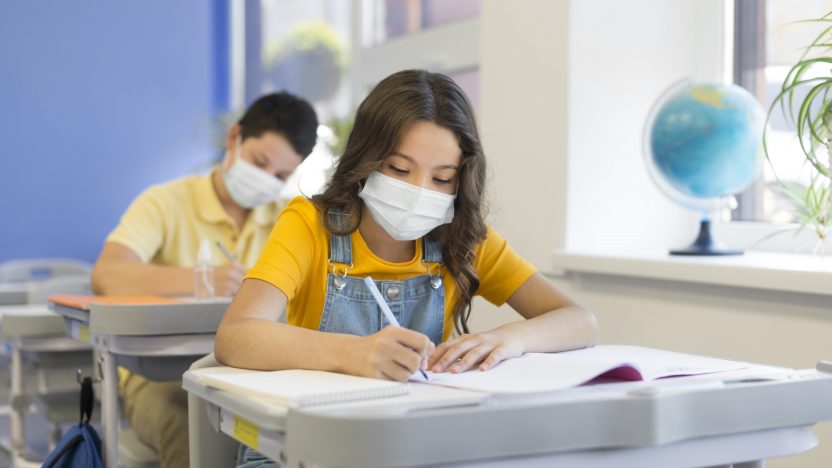The closure of pre-schools, general educational institutions of secondary and higher education on the grounds of COVID-19-related restrictions in 191 countries has forced 1.57 billion pupils and students (90% of the world’s population of students) to study remotely.
On the one hand, such situation was quite justified, because it helped to protect people from the risk of contracting COVID-19. On the other hand, quarantine has posed new challenges to educational institutions as well as education authorities at the local and national levels.
How to organize the effective remote or mixed learning process, how to adapt the educational policy to the present day requirements, how to boost the financial support of educational institutions, how to modernize their logistical and material resources – this is not a complete list of challenges that managers and educators are faced with, as they address the beginning of the new 2020-2021 academic year.
The policy brief “Educational Process in Schools of Ukraine in Quarantine” is designed to help identify the main ways to overcome the outlined challenges at different levels of government.
The authors of the policy brief have examined the international best practices of running schools during the pandemic, analyzed the legal framework underpinning the educational process in Ukraine, the status of logistical and technological resources in education and possibilities for upgrading them in quarantine, the state of readiness of the national system to re-train teachers, and other challenges faced by the Ukrainian educators in the new school year.
Based on the review of logistical and technological resources in schools of Ukraine during quarantine, the status of digital competence of teachers and students, and the available digital tools in education, the following general conclusions were made:
1. The vast majority of schools in Ukraine (over 60%) do not have broadband Internet access to allow them to be able to work with quality educational content. This problem is especially typical for the rural areas.
2. The average number of students per one desktop or laptop computer is 9.2.
3. As a result of the survey, it has been established that every fourth respondent does not have the necessary technical tools for the quality education. More than 9% of respondents assess the available technical resources as extremely poor.
4. Majority of secondary education institutions are not prepared for the introduction of remote e-learning format (synchronous, asynchronous) in view of the following problem issues identified: no relevant digital education policy; low level of digital competence of administration, teachers and students; lack of the educational platform accessible to all participants in the educational process using their own resources; adjusting technologies and forms of traditional learning to distance learning format; lack of clear guidelines for teachers on the use of mixed learning technologies in the educational process based on asynchronous and synchronous formats; lack of a unified policy on the use of digital tools; lack of methodological and technological assistance and support for teachers to implement remote learning; lack of effective communication with parents on the distribution of responsibilities for the quality of student learning outcomes and specifics of distance learning for different categories of children and others.
5. In order to provide students with access to educational content, we constantly expand the list of educational projects, platforms offering open online courses, sites containing educational and methodological materials, as well as manuals for teacher training and re-training.
The proposed policy brief contains guidelines how to organize the educational process in general secondary education institutions of Ukraine in the new school year. The recommendations were developed based on the study of the best practices identified internationally and domestically, as well as the review of experience, inquiries and suggestions submitted by educators and the analysis of the current legal framework in education.
The guidelines are structured according to the six principles of the Framework Program for School Renewal developed by UNESCO, UNICEF, the World Food Program and the World Bank: policy reform, funding requirements, safe operation, compensation for learning, welfare and protection, and covering the most marginalized.
1. Policy reform. The implications of the policy cover all aspects of the guidelines, including policies to open and to close schools during public health emergencies; reforms needed to expand equitable access to education for children from marginalized and out-of-school groups, and recommendations to enhance and standardize remote learning practices.
2. Funding requirements. To overcome the negative impact of COVID-19 and invest in improving the education to restore and increase its resilience.
3. Safe operation. Ensure conditions are in place to prevent the spread of COVID-19. Make sure basic services and materials are provided in compliance with sanitary regulations. In particular, ensuring access to the means of hand hygiene, compliance with social distancing protocols and procedures for providing medical care in case of illness.
4. Compensation for learning process. The use of teaching practices that compensate for the loss of learning time and enhance the teaching methodology. Such teaching practices shall be based on such hybrid learning models as the integration of approaches in remote and distance learning. Such practices shall include educational campaigns on the transmission and prevention of COVID-19.
5. Well-being and protection. Extra attention to the well-being and protection of students by improving the quality educational services, as well as catering of school meals and health services.
6. Covering the most marginalized children. Adapting school policies and practices to increase access to education for marginalized groups, including pre-school children, displaced children and migrants, as well as representatives of minorities. Diversification of critical communication and educational efforts by ensuring its accessibility in minority languages, in accessible formats, adapted to the needs of marginalized groups.
Read the guidelines in full – here.
The policy brief “Educational Process in Schools of Ukraine in Quarantine” was prepared by “EducationAnalytics” think tank of Kyiv University named after Borys Grinchenko, created with the support of the International Renaissance Foundation and the Embassy of Sweden.

